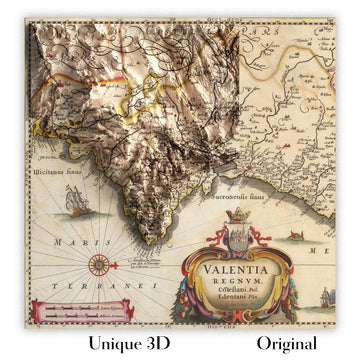

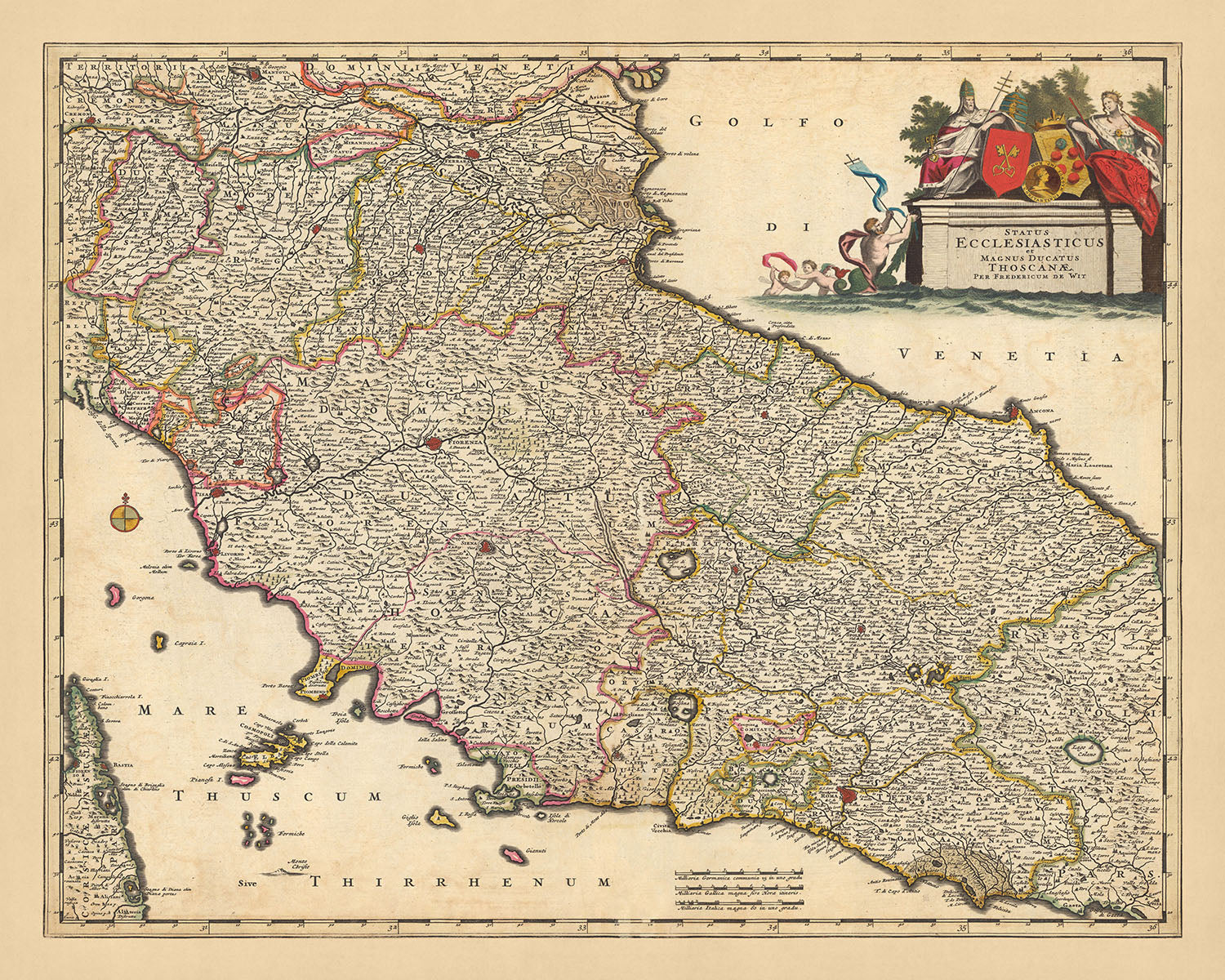

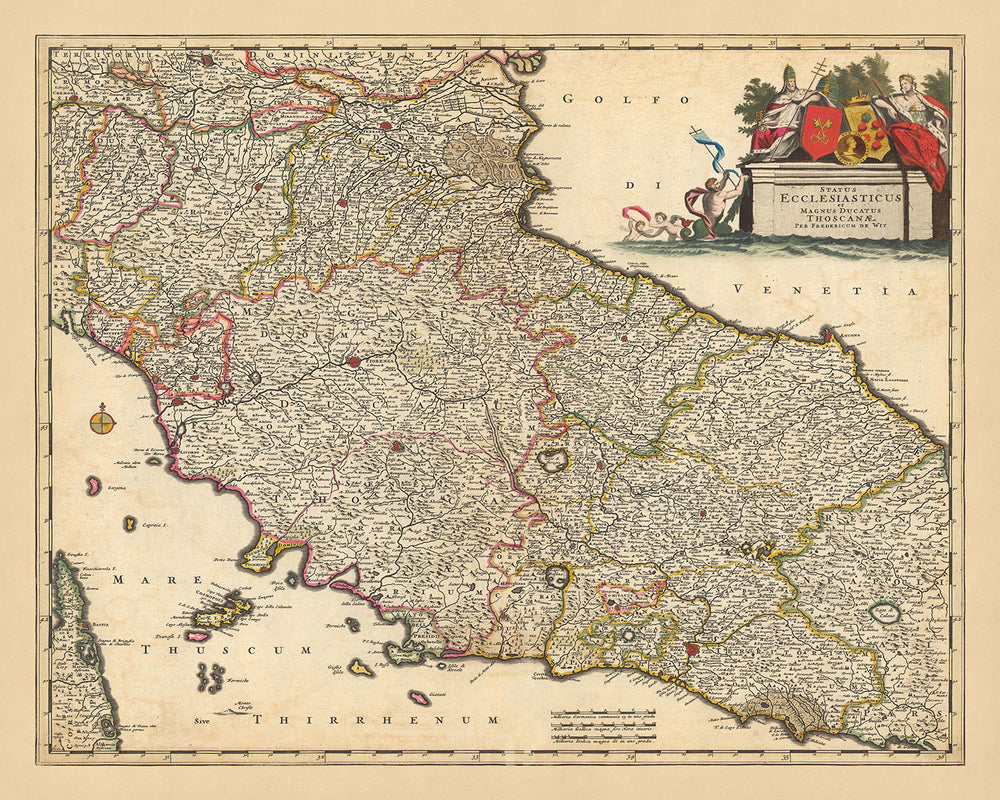

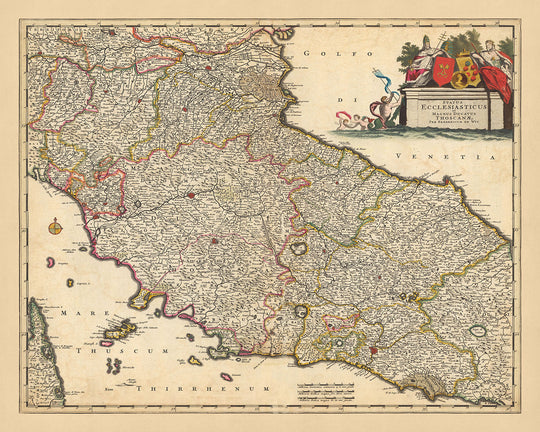











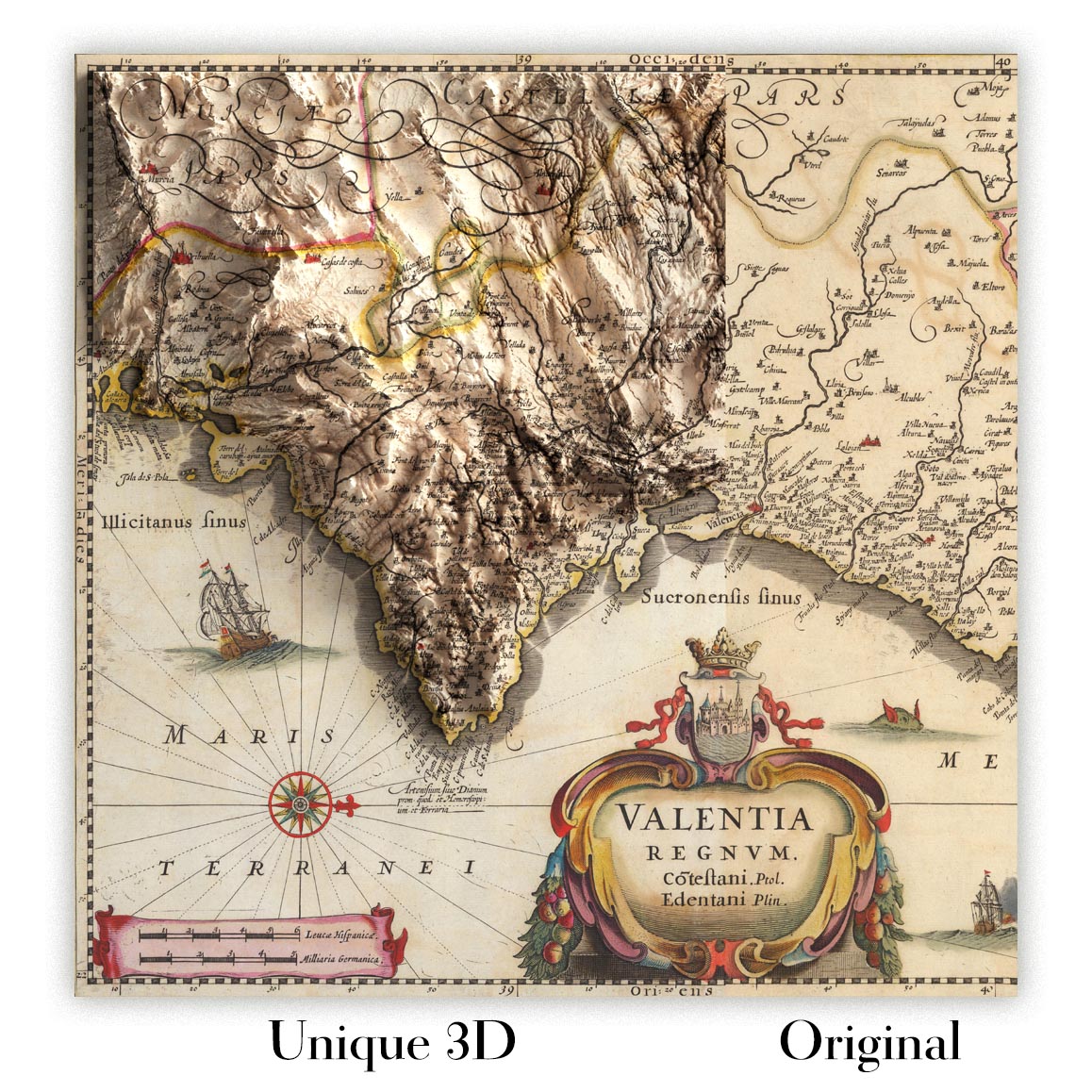



Old Map of Papal States & Duchy of Tuscany, Italy by Visscher, 1690: Rome, Florence, Pescara, Bologna, Pisa


-
![]() Handmade in the UK (we're based in London)
Handmade in the UK (we're based in London)
-
FREE worldwide delivery in 2-3 days ⓘ
Free Christmas delivery in 2-3 days
Your map should be delivered in 2-3 working days with free delivery, worldwide.
We make maps by hand locally in 23 countries, including the UK
![]() . If you're buying a gift for someone in another country, we will make the map locally to them.
. If you're buying a gift for someone in another country, we will make the map locally to them.You will never pay import tax or customs duty.
Check the Christmas delivery guide for order deadlines.
Express delivery is available at checkout which can reduce the delivery time to 1-2 days.
Please note that personalised maps, and larger framed maps, can take longer to produce and deliver.
If you need your order to arrive by a certain date, contact me and we can discuss your options.
-
90 day money back guarantee
ⓘ
90 days to return and refund
Products can be returned within 90 days for a full refund, or exchange for another product.
For personalised and custom made items, we may offer you store credit or a non-expiring gift card, as we cannot resell personalised orders.
If you have any questions, get in touch. For more information, see our full returns & exchanges policy.

My maps are rare, museum-grade, restored old maps sourced from libraries, auction houses and private collections across the globe.
Framing & free personalisation available
1. Select your size
➢ Pick the closest size (above)
➢ Provide the exact size in millimetres
➢ Add to bag and checkout as normal
2. Frame & personalise your map
Make your map unique with framing, hand-drawn customisation, vintage ageing, pop art text, unique 3D styling and moreGift message & custom finish

If you want to add a gift message, or a finish (jigsaw, aluminium board, etc.) that is not available here, please request it in the "order note" when you check out.
Every order is custom made, so if you need the size adjusted slightly, or printed on an unusual material, just let us know. We've done thousands of custom orders over the years, so there's (almost) nothing we can't manage.
You can also contact us before you order, if you prefer!

- Handmade locally. No import duty or tax
- FREE Delivery. Arrives in 2-3 days
- Love it or your money back
- Questions? WhatsApp me any time
Own a piece of history
5,000+ 5 star reviews


Immerse yourself in the grandeur of the past with our meticulously detailed map, 'Status Ecclesiasticus et Magnus Ducatus Thoscanae'. Translated from Latin, the title refers to the 'Ecclesiastical State and Grand Duchy of Tuscany', which is the primary focus of this cartographic masterpiece. Crafted by Nicolaes Visscher II in 1690, this map showcases the political and geographical divisions of the Papal States and the Grand Duchy of Tuscany, regions now part of modern-day Italy. Visscher, a notable figure from the Dutch Golden Age, was the grandson of Claes Janszoon Visscher, renowned for his exquisite mapmaking skills.
The map offers a comprehensive view of the key cities of Rome, Florence, Pescara, Bologna, and Pisa. Each city is meticulously represented, offering a glimpse into the historical urban landscapes of the era. The map is not merely a geographical guide, but a historical document that narrates the tale of these cities and their significant roles in shaping the political and cultural fabric of Italy.
In addition to the cities, the map showcases various landmarks, including forests, waterways, canals, mountains, and other notable features. The map's decorative title cartouche, coat of arms, and compass rose add an artistic flair, making it a visual delight. The relief is shown pictorially, adding depth and dimension to the map, bringing the landscapes to life.
The map is hand-colored and engraved, emphasizing the administrative boundaries of the regions. It provides an insight into the political divisions of the time, offering a historical perspective on the governance and jurisdiction of these regions. This map is not just a piece of art, but a testament to the cartographic excellence of the Dutch Golden Age, and a historical document that offers a glimpse into the past. It is a must-have for collectors and history enthusiasts alike, promising to be a conversation starter and a centerpiece in any setting.
Some of the significant locations shown on this map:
Ecclesiastical State (Papal States):
- Rome - Known as the Eternal City, it was the capital of the Papal States. Also known as Roma in Italian.
- Bologna - Known for its rich history, culture, and cuisine. Also known as Bononia in Latin.
- Ferrara - A significant cultural and economic center during the Renaissance. Also known as Ferrariae in Latin.
- Ravenna - Famous for its stunning Byzantine mosaics. Also known as Ravennae in Latin.
- Perugia - Known for its Etruscan arch and other historical monuments. Also known as Perusia in Latin.
- Ancona - An important sea port on the Adriatic Sea. Also known as Ancon in Latin.
- Urbino - A walled city in the Marche, it was a center of the Italian Renaissance. Also known as Urbinum Mataurense in Latin.
- Spoleto - Known for its Roman, medieval, and Renaissance architecture. Also known as Spoletium in Latin.
- Ascoli Piceno - Known for its travertine buildings and beautiful squares. Also known as Asculum in Latin.
- Fano - An ancient town and comune of the province of Pesaro and Urbino. Also known as Fanum Fortunae in Latin.
- Pesaro - Known for its rich musical tradition. Also known as Pisaurum in Latin.
- Cesena - Known for its rich history and culture. Also known as Caesena in Latin.
- Rimini - A popular tourist destination for its rich history and beaches. Also known as Ariminum in Latin.
- Forlì - Known for its rich history and culture. Also known as Forum Livii in Latin.
- Faenza - Known for its ceramics production, Faenza majolica. Also known as Faventia in Latin.
Grand Duchy of Tuscany:
- Florence - The capital of the Grand Duchy of Tuscany, known for its Renaissance art and architecture. Also known as Firenze in Italian.
- Pisa - Known for its iconic Leaning Tower. Also known as Pisae in Latin.
- Siena - Known for its medieval cityscape. Also known as Sena Julia in Latin.
- Lucca - Known for its well-preserved Renaissance walls. Also known as Luca in Latin.
- Arezzo - Known for its significant contributions to the culture and history of Italy. Also known as Arretium in Latin.
- Pistoia - Known for its rich history and culture. Also known as Pistoria in Latin.
- Livorno - An important seaport in Italy. Also known as Labro in Latin.
- Grosseto - Known for its beautiful landscapes and rich history. Also known as Grossetium in Latin.
- Prato - Known for its textile industry. Also known as Pratum in Latin.
- Pescia - Known for its rich history and culture. Also known as Piscia in Latin.
- San Gimignano - Known for its medieval architecture. Also known as Silvia in Latin.
- Volterra - Known for its Etruscan history and alabaster production. Also known as Volaterrae in Latin.
- Cortona - Known for its Etruscan history and architecture. Also known as Corito in Latin.
- Massa Marittima - Known for its rich history and culture. Also known as Massa Veternensis in Latin.
- Follonica - Known for its beautiful beaches and landscapes. Also known as Follonica in Latin.
Notable Natural Phenomena:
- The Apennine Mountains - A mountain range stretching from north to south along Italy's eastern coast.
- The Arno River - A major river in the region, known for its significance in the development of many cities.
- The Tiber River - The third-longest river in Italy, it passes through Rome.
- The Tyrrhenian Sea - Part of the Mediterranean Sea off the western coast of Italy.
- The Adriatic Sea - Located on the eastern coast of Italy.
Notable Historical Events (1600-1690):
- The completion of St. Peter's Basilica - In 1626, the construction of the largest Christian church was completed in Rome.
- The War of Castro - From 1641 to 1649, a series of conflicts in the Papal States led by Pope Urban VIII.
- The Great Plague of Florence - A devastating outbreak of Bubonic Plague that struck the city of Florence from 1630 to 1633.
Please double check the images to make sure that a specific town or place is shown on this map. You can also get in touch and ask us to check the map for you.
This map looks great at all sizes: 12x16in (30.5x41cm), 16x20in (40.5x51cm), 18x24in (45.5x61cm), 24x30in (61x76cm), 32x40in (81.5x102cm), 40x50in (102x127cm), 48x60in (122x153cm) and 56x70in (142x178cm), but it looks even better when printed large.
I can create beautiful, large prints of this map up to 90in (229cm). Please get in touch if you're looking for larger, customised or different framing options.
The model in the listing images is holding the 16x20in (40.5x51cm) version of this map.
The fifth listing image shows an example of my map personalisation service.
If you’re looking for something slightly different, check out my collection of the best old maps of Europe and European cities to see if something else catches your eye.
Please contact me to check if a certain location, landmark or feature is shown on this map.
This would make a wonderful birthday, Christmas, Father's Day, work leaving, anniversary or housewarming gift for someone from the areas covered by this map.
This map is available as a giclée print on acid free archival matte paper, or you can buy it framed. The frame is a nice, simple black frame that suits most aesthetics. Please get in touch if you'd like a different frame colour or material. My frames are glazed with super-clear museum-grade acrylic (perspex/acrylite), which is significantly less reflective than glass, safer, and will always arrive in perfect condition.
This map is also available as a float framed canvas, sometimes known as a shadow gap framed canvas or canvas floater. The map is printed on artist's cotton canvas and then stretched over a handmade box frame. We then "float" the canvas inside a wooden frame, which is available in a range of colours (black, dark brown, oak, antique gold and white). This is a wonderful way to present a map without glazing in front. See some examples of float framed canvas maps and explore the differences between my different finishes.
For something truly unique, this map is also available in "Unique 3D", our trademarked process that dramatically transforms the map so that it has a wonderful sense of depth. We combine the original map with detailed topography and elevation data, so that mountains and the terrain really "pop". For more info and examples of 3D maps, check my Unique 3D page.
For most orders, delivery time is about 3 working days. Personalised and customised products take longer, as I have to do the personalisation and send it to you for approval, which usually takes 1 or 2 days.
Please note that very large framed orders usually take longer to make and deliver.
If you need your order to arrive by a certain date, please contact me before you order so that we can find the best way of making sure you get your order in time.
I print and frame maps and artwork in 23 countries around the world. This means your order will be made locally, which cuts down on delivery time and ensures that it won't be damaged during delivery. You'll never pay customs or import duty, and we'll put less CO2 into the air.
All of my maps and art prints are well packaged and sent in a rugged tube if unframed, or surrounded by foam if framed.
I try to send out all orders within 1 or 2 days of receiving your order, though some products (like face masks, mugs and tote bags) can take longer to make.
If you select Express Delivery at checkout your order we will prioritise your order and send it out by 1-day courier (Fedex, DHL, UPS, Parcelforce).
Next Day delivery is also available in some countries (US, UK, Singapore, UAE) but please try to order early in the day so that we can get it sent out on time.
My standard frame is a gallery style black ash hardwood frame. It is simple and quite modern looking. My standard frame is around 20mm (0.8in) wide.
I use super-clear acrylic (perspex/acrylite) for the frame glass. It's lighter and safer than glass - and it looks better, as the reflectivity is lower.
Six standard frame colours are available for free (black, dark brown, dark grey, oak, white and antique gold). Custom framing and mounting/matting is available if you're looking for something else.
Most maps, art and illustrations are also available as a framed canvas. We use matte (not shiny) cotton canvas, stretch it over a sustainably sourced box wood frame, and then 'float' the piece within a wood frame. The end result is quite beautiful, and there's no glazing to get in the way.
All frames are provided "ready to hang", with either a string or brackets on the back. Very large frames will have heavy duty hanging plates and/or a mounting baton. If you have any questions, please get in touch.
See some examples of my framed maps and framed canvas maps.
Alternatively, I can also supply old maps and artwork on canvas, foam board, cotton rag and other materials.
If you want to frame your map or artwork yourself, please read my size guide first.
My maps are extremely high quality reproductions of original maps.
I source original, rare maps from libraries, auction houses and private collections around the world, restore them at my London workshop, and then use specialist giclée inks and printers to create beautiful maps that look even better than the original.
My maps are printed on acid-free archival matte (not glossy) paper that feels very high quality and almost like card. In technical terms the paper weight/thickness is 10mil/200gsm. It's perfect for framing.
I print with Epson ultrachrome giclée UV fade resistant pigment inks - some of the best inks you can find.
I can also make maps on canvas, cotton rag and other exotic materials.
Learn more about The Unique Maps Co.
Map personalisation
If you're looking for the perfect anniversary or housewarming gift, I can personalise your map to make it truly unique. For example, I can add a short message, or highlight an important location, or add your family's coat of arms.
The options are almost infinite. Please see my map personalisation page for some wonderful examples of what's possible.
To order a personalised map, select "personalise your map" before adding it to your basket.
Get in touch if you're looking for more complex customisations and personalisations.
Map ageing
I have been asked hundreds of times over the years by customers if they could buy a map that looks even older.
Well, now you can, by selecting Aged before you add a map to your basket.
All the product photos you see on this page show the map in its Original form. This is what the map looks like today.
If you select Aged, I will age your map by hand, using a special and unique process developed through years of studying old maps, talking to researchers to understand the chemistry of aging paper, and of course... lots of practice!
If you're unsure, stick to the Original colour of the map. If you want something a bit darker and older looking, go for Aged.
If you are not happy with your order for any reason, contact me and I'll get it fixed ASAP, free of charge. Please see my returns and refund policy for more information.
I am very confident you will like your restored map or art print. I have been doing this since 1984. I'm a 5-star Etsy seller. I have sold tens of thousands of maps and art prints and have over 5,000 real 5-star reviews. My work has been featured in interior design magazines, on the BBC, and on the walls of dozens of 5-star hotels.
I use a unique process to restore maps and artwork that is massively time consuming and labour intensive. Hunting down the original maps and illustrations can take months. I use state of the art and eye-wateringly expensive technology to scan and restore them. As a result, I guarantee my maps and art prints are a cut above the rest. I stand by my products and will always make sure you're 100% happy with what you receive.
Almost all of my maps and art prints look amazing at large sizes (200cm, 6.5ft+) and I can frame and deliver them to you as well, via special oversized courier. Contact me to discuss your specific needs.
Or try searching for something!
This service is currently unavailable,
sorry for the inconvenience.
Pair it with a frame
Frame options are for visualization purposes only.
FRAME STYLE
MATTING SIZE
BUILDING YOUR EXPERIENCE
powered by Blankwall
Take a few steps back and let your camera see more of the scene.
powered by Blankwall
Was this experience helpful?
Immerse yourself in the grandeur of the past with our meticulously detailed map, 'Status Ecclesiasticus et Magnus Ducatus Thoscanae'. Translated from Latin, the title refers to the 'Ecclesiastical State and Grand Duchy of Tuscany', which is the primary focus of this cartographic masterpiece. Crafted by Nicolaes Visscher II in 1690, this map showcases the political and geographical divisions of the Papal States and the Grand Duchy of Tuscany, regions now part of modern-day Italy. Visscher, a notable figure from the Dutch Golden Age, was the grandson of Claes Janszoon Visscher, renowned for his exquisite mapmaking skills.
The map offers a comprehensive view of the key cities of Rome, Florence, Pescara, Bologna, and Pisa. Each city is meticulously represented, offering a glimpse into the historical urban landscapes of the era. The map is not merely a geographical guide, but a historical document that narrates the tale of these cities and their significant roles in shaping the political and cultural fabric of Italy.
In addition to the cities, the map showcases various landmarks, including forests, waterways, canals, mountains, and other notable features. The map's decorative title cartouche, coat of arms, and compass rose add an artistic flair, making it a visual delight. The relief is shown pictorially, adding depth and dimension to the map, bringing the landscapes to life.
The map is hand-colored and engraved, emphasizing the administrative boundaries of the regions. It provides an insight into the political divisions of the time, offering a historical perspective on the governance and jurisdiction of these regions. This map is not just a piece of art, but a testament to the cartographic excellence of the Dutch Golden Age, and a historical document that offers a glimpse into the past. It is a must-have for collectors and history enthusiasts alike, promising to be a conversation starter and a centerpiece in any setting.
Some of the significant locations shown on this map:
Ecclesiastical State (Papal States):
- Rome - Known as the Eternal City, it was the capital of the Papal States. Also known as Roma in Italian.
- Bologna - Known for its rich history, culture, and cuisine. Also known as Bononia in Latin.
- Ferrara - A significant cultural and economic center during the Renaissance. Also known as Ferrariae in Latin.
- Ravenna - Famous for its stunning Byzantine mosaics. Also known as Ravennae in Latin.
- Perugia - Known for its Etruscan arch and other historical monuments. Also known as Perusia in Latin.
- Ancona - An important sea port on the Adriatic Sea. Also known as Ancon in Latin.
- Urbino - A walled city in the Marche, it was a center of the Italian Renaissance. Also known as Urbinum Mataurense in Latin.
- Spoleto - Known for its Roman, medieval, and Renaissance architecture. Also known as Spoletium in Latin.
- Ascoli Piceno - Known for its travertine buildings and beautiful squares. Also known as Asculum in Latin.
- Fano - An ancient town and comune of the province of Pesaro and Urbino. Also known as Fanum Fortunae in Latin.
- Pesaro - Known for its rich musical tradition. Also known as Pisaurum in Latin.
- Cesena - Known for its rich history and culture. Also known as Caesena in Latin.
- Rimini - A popular tourist destination for its rich history and beaches. Also known as Ariminum in Latin.
- Forlì - Known for its rich history and culture. Also known as Forum Livii in Latin.
- Faenza - Known for its ceramics production, Faenza majolica. Also known as Faventia in Latin.
Grand Duchy of Tuscany:
- Florence - The capital of the Grand Duchy of Tuscany, known for its Renaissance art and architecture. Also known as Firenze in Italian.
- Pisa - Known for its iconic Leaning Tower. Also known as Pisae in Latin.
- Siena - Known for its medieval cityscape. Also known as Sena Julia in Latin.
- Lucca - Known for its well-preserved Renaissance walls. Also known as Luca in Latin.
- Arezzo - Known for its significant contributions to the culture and history of Italy. Also known as Arretium in Latin.
- Pistoia - Known for its rich history and culture. Also known as Pistoria in Latin.
- Livorno - An important seaport in Italy. Also known as Labro in Latin.
- Grosseto - Known for its beautiful landscapes and rich history. Also known as Grossetium in Latin.
- Prato - Known for its textile industry. Also known as Pratum in Latin.
- Pescia - Known for its rich history and culture. Also known as Piscia in Latin.
- San Gimignano - Known for its medieval architecture. Also known as Silvia in Latin.
- Volterra - Known for its Etruscan history and alabaster production. Also known as Volaterrae in Latin.
- Cortona - Known for its Etruscan history and architecture. Also known as Corito in Latin.
- Massa Marittima - Known for its rich history and culture. Also known as Massa Veternensis in Latin.
- Follonica - Known for its beautiful beaches and landscapes. Also known as Follonica in Latin.
Notable Natural Phenomena:
- The Apennine Mountains - A mountain range stretching from north to south along Italy's eastern coast.
- The Arno River - A major river in the region, known for its significance in the development of many cities.
- The Tiber River - The third-longest river in Italy, it passes through Rome.
- The Tyrrhenian Sea - Part of the Mediterranean Sea off the western coast of Italy.
- The Adriatic Sea - Located on the eastern coast of Italy.
Notable Historical Events (1600-1690):
- The completion of St. Peter's Basilica - In 1626, the construction of the largest Christian church was completed in Rome.
- The War of Castro - From 1641 to 1649, a series of conflicts in the Papal States led by Pope Urban VIII.
- The Great Plague of Florence - A devastating outbreak of Bubonic Plague that struck the city of Florence from 1630 to 1633.
Please double check the images to make sure that a specific town or place is shown on this map. You can also get in touch and ask us to check the map for you.
This map looks great at all sizes: 12x16in (30.5x41cm), 16x20in (40.5x51cm), 18x24in (45.5x61cm), 24x30in (61x76cm), 32x40in (81.5x102cm), 40x50in (102x127cm), 48x60in (122x153cm) and 56x70in (142x178cm), but it looks even better when printed large.
I can create beautiful, large prints of this map up to 90in (229cm). Please get in touch if you're looking for larger, customised or different framing options.
The model in the listing images is holding the 16x20in (40.5x51cm) version of this map.
The fifth listing image shows an example of my map personalisation service.
If you’re looking for something slightly different, check out my collection of the best old maps of Europe and European cities to see if something else catches your eye.
Please contact me to check if a certain location, landmark or feature is shown on this map.
This would make a wonderful birthday, Christmas, Father's Day, work leaving, anniversary or housewarming gift for someone from the areas covered by this map.
This map is available as a giclée print on acid free archival matte paper, or you can buy it framed. The frame is a nice, simple black frame that suits most aesthetics. Please get in touch if you'd like a different frame colour or material. My frames are glazed with super-clear museum-grade acrylic (perspex/acrylite), which is significantly less reflective than glass, safer, and will always arrive in perfect condition.











